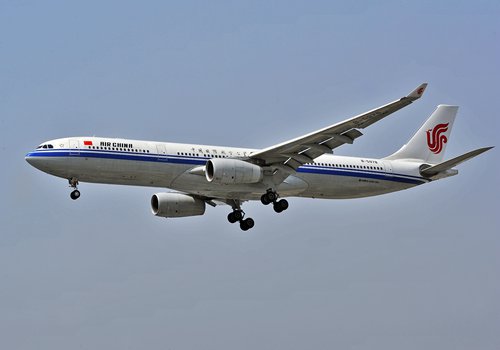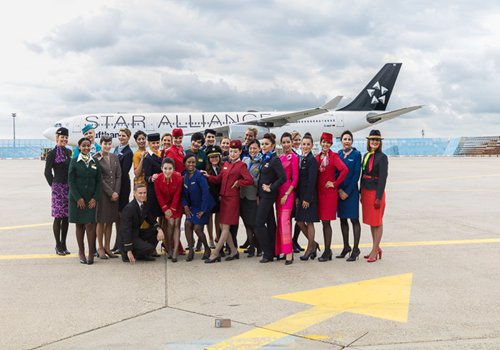
Photo: IC

Flight attendants pose for photos in front of a Star Alliance aircraft. Photo: Courtesy of Star Alliance
Shanghai-based Juneyao Airlines announced Tuesday that it has become a Star Alliance "Connecting Partner," in a development that the airline hopes will help advance its global expansion plans.
By joining the Star Alliance program, Juneyao could increase its number of weekly flights for alliance passengers to 1,700 to 69 destinations in eight countries and regions. Meanwhile, the deal will help alliance members extend their networks on the Chinese mainland.
It is widely believed that Juneyao's addition will benefit the alliance's network in Shanghai as the rapidly growing regional market has been a weak spot for the alliance since Shanghai Airlines quit Star Alliance after merging with China Eastern Airlines in 2010.
"With Juneyao Airlines, we strengthen our market position in Shanghai, a city which is already served by 17 of our member airlines and which will now offer even better connectivity to our customers," Star Alliance CEO Jeffrey Goh said in a press release.
Expanding map
The Juneyao deal followed Star Alliance's 20th anniversary celebration in Frankfurt, Germany, earlier in May, when alliance announced its strategy to harness technology over the next decade to enhance its customers' experience.
The alliance said its strategic focus has shifted from network expansion to providing a seamless experience to the more than 14 million passengers a year who transfer flights between alliance airlines.
The alliance said the baggage hub, the most recent IT hub project, went live at the end of 2016, and facilitates baggage message transfer between the member airlines, their ground handlers and the baggage handling systems at the airports. Today it processes on average 5 million baggage messages a day.
Currently, Star Alliance has 28 member airlines, including Lufthansa, Turkish Airlines and Singapore Airlines. The alliance's network covers more than 1,300 destinations in 191 countries and regions.
On the mainland, Air China and Shenzhen Airlines are in Star Alliance. Air China joined the alliance in December 2007. China Eastern Airlines and China Southern Airlines are members of Star Alliance's rival SkyTeam.
In 2016, Air China launched 45 new flight routes, both domestic and international, to advance its hub network strategy.
As the largest airline flying between China and Europe and China and the US, the company has continuously expanded its reach around the world, with growth of 49 percent in the volume of connecting passengers between international flights.
At the end of 2016, Air China had 378 passenger routes. The airline's network covered 176 cities in 41 countries and regions. Through Star Alliance, its network reaches 1,330 destinations in 192 countries and regions.
In 2015, Star Alliance launched its Connecting Partner Model program, which aims to help select local and regional airlines reach agreements with its members to expand the alliance's network.
The program gives alliance passengers access to additional travel options beyond the current 1,300 airports served by the alliance.
Wang Junjin, chairman of Juneyao Airlines, said Tuesday at a press conference in Shanghai that the program was a good model because of the flexibility it provides, according to a report in the China Business News.
Loosening alliances
In March, American Airlines invested $200 million in 270 million Hong Kong-listed shares of China Southern Airlines Co.
In the same month, Hong Kong-based Cathay Pacific and Lufthansa Group, Europe's leading airline group, announced that they had reached a deal to offer passengers selected flights under each other's flight numbers.
Both of the deals received a lot of attention because American Airlines and Cathay Pacific are founding members of the Oneworld airline alliance, yet Lufthansa is a member of Star Alliance and China Southern is a member of SkyTeam.
When asked whether these cross-alliance deals were a sign that airline alliances were weakening, Goh told the Global Times on May 13 that "we have exceptions. As business involves, we have to recognize that we have the requirement to have cooperation as an exception of the alliance."
From time to time, Star Alliance members seek to work with other airlines to better serve their commercial strategies because Star Alliance doesn't cover every corner of the globe, Goh said. Still, the alliance has the largest code-sharing network, and code flights within the alliance grew four times faster than the number of flights operated by members over the last 10 years.
"In our view [the cross-alliance deals] remain exceptions, as code-sharing and cooperation between the members remain the core of the alliance," Goh noted.

